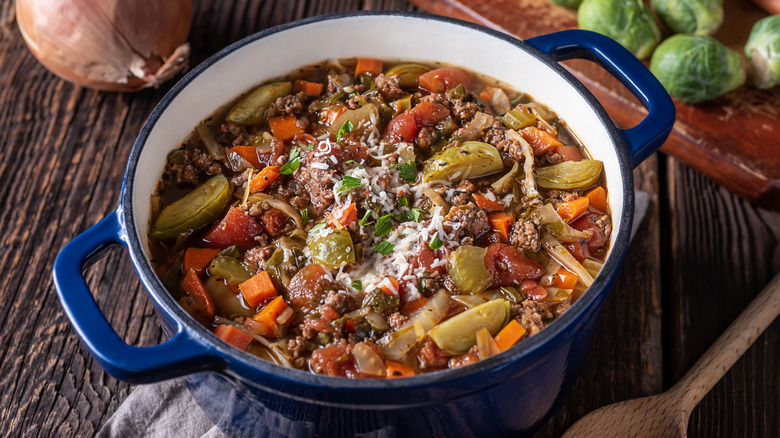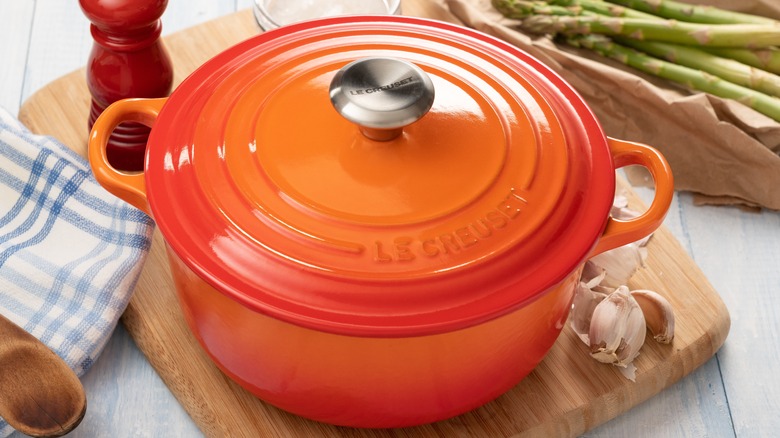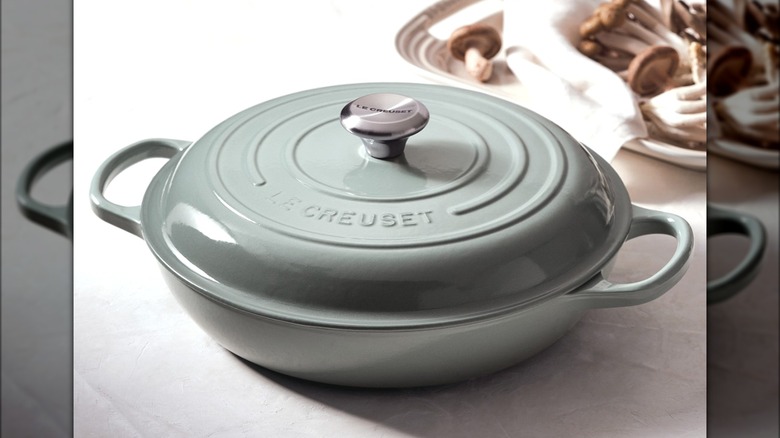Is There Really A Difference Between A Dutch Oven And A Braiser?
Customarily made with seasoned ceramic or enameled cast iron materials, Dutch ovens and braisers have several similarities and are easy to confuse if you don't do a lot of cooking. They both have solid lids and handles, thick sides to retain heat, and can be used in the oven or on the stovetop. However, the primary difference between the two is the shape, which makes each more suitable than the other for specific kitchen applications.
The Dutch oven has an interesting origin story, and its tall walls and low-profile lid have always made it ideal for preparing meals slowly at low temperatures. Accommodating lots of liquid, it's perfect for making soups, deep frying foods, and baking casseroles or even bread.
By comparison, a braiser is like a hybrid of a pot and a pan, and it has a dome-shaped lid for steam circulation, shorter and curved sides, and a wider base. The broader bottom allows ingredients to be exposed to high temperatures evenly, rendering it perfect for (no surprise) braising, as well as shallow frying and searing, tenderizing tough meats, and roasting — generally, making dishes that require little liquid.
Dutch oven options and clever uses
When it comes to choosing a Dutch oven for your kitchen, you have an array of sizes to consider. The sizes are categorized in increments of quarts, indicating how much volume each can hold — from 1 to 3 quarts (small) to more than 9 quarts (extra large). For reference, a whole chicken can fit in a medium, 4- to 5-quart Dutch oven.
Additionally, this cooking tool comes in round and oval shapes. If your stovetop has circular burners, you don't want to get an oval oven because the ends will extend past the heating element, causing poor heat distribution and making it hard to get an even cook. Instead, only get the oval shape if you have elliptical or super-sized burners, or primarily want to use it in the oven.
No matter which shape you choose, a Dutch oven is well suited for tons of slow cooker recipes. Or, use your Dutch oven to make pasta dishes without worrying about splatter. The tall sides hinder liquids from escaping onto your stove surface or yourself, which is why cooks like this kitchen tool for deep frying. Plus, the Dutch oven makes baking bread easy, helping to achieve that holy grail crispy crust and moist crumb. You can use it for smoking meats indoors, steaming veggies and dinner rolls, and warming up desserts, too. The most creative uses, though, might be as an ice bucket for chilled party beverages and using the lid as a baking surface.
Braiser selection and inventive cooking techniques
Unlike a Dutch oven, the size of a braiser can be based on two things: one) the diameter of the opening, which typically ranges from 10 to 12 inches, and two) how much volume can fit inside, which usually ranges from 2 to 6 quarts. The depth of a braiser is most often 2 ½ inches. For reference, a 3- or 4-quart braiser will do the trick nicely if you're cooking for three or four people, but you can get a larger braiser if you like to make big meals for dinner parties or prepare food for the week ahead.
In any case, this multipurpose tool is so well-rounded that you can use it almost daily, including for simple tasks like frying eggs. The shape is great for cooking chunky chilis, stews, casseroles, and even biscuits as well. On the sweeter side, you can use it to make cakes, cobblers, giant cookies, and apple fritters. Or, pull out your braiser to make a savory or sweet bread pudding or to toast sandwiches if you don't have a panini press.


